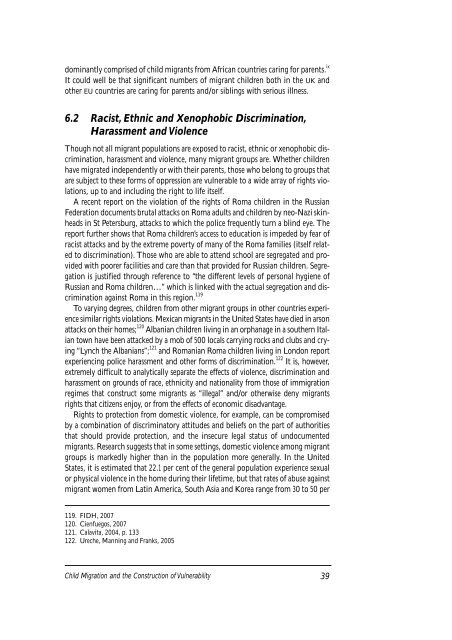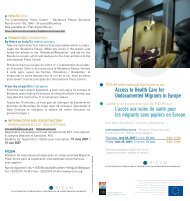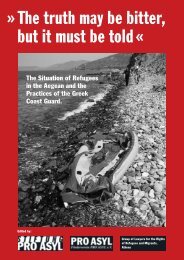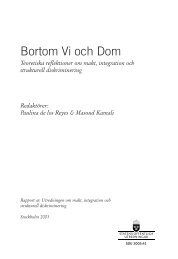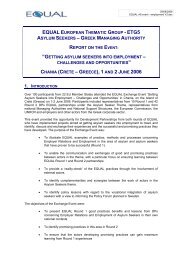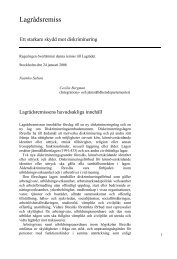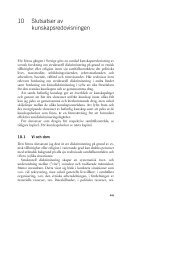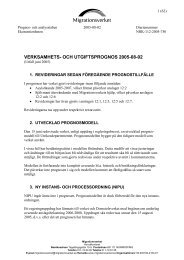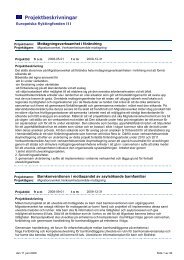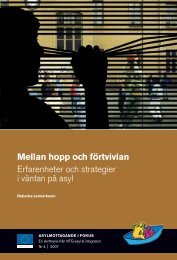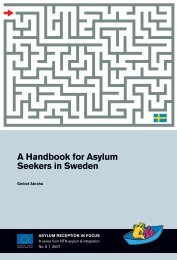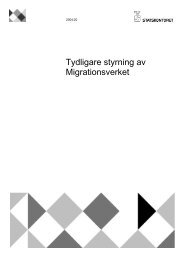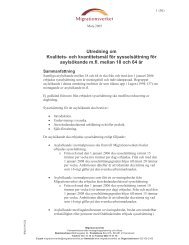and the Construction of Vulnerability - Child Trafficking
and the Construction of Vulnerability - Child Trafficking
and the Construction of Vulnerability - Child Trafficking
You also want an ePaper? Increase the reach of your titles
YUMPU automatically turns print PDFs into web optimized ePapers that Google loves.
dominantly comprised <strong>of</strong> child migrants from African countries caring for parents. ix<br />
It could well be that significant numbers <strong>of</strong> migrant children both in <strong>the</strong> UK <strong>and</strong><br />
o<strong>the</strong>r EU countries are caring for parents <strong>and</strong>/or siblings with serious illness.<br />
6.2 Racist, Ethnic <strong>and</strong> Xenophobic Discrimination,<br />
Harassment <strong>and</strong> Violence<br />
Though not all migrant populations are exposed to racist, ethnic or xenophobic discrimination,<br />
harassment <strong>and</strong> violence, many migrant groups are. Whe<strong>the</strong>r children<br />
have migrated independently or with <strong>the</strong>ir parents, those who belong to groups that<br />
are subject to <strong>the</strong>se forms <strong>of</strong> oppression are vulnerable to a wide array <strong>of</strong> rights violations,<br />
up to <strong>and</strong> including <strong>the</strong> right to life itself.<br />
A recent report on <strong>the</strong> violation <strong>of</strong> <strong>the</strong> rights <strong>of</strong> Roma children in <strong>the</strong> Russian<br />
Federation documents brutal attacks on Roma adults <strong>and</strong> children by neo-Nazi skinheads<br />
in St Petersburg, attacks to which <strong>the</strong> police frequently turn a blind eye. The<br />
report fur<strong>the</strong>r shows that Roma children’s access to education is impeded by fear <strong>of</strong><br />
racist attacks <strong>and</strong> by <strong>the</strong> extreme poverty <strong>of</strong> many <strong>of</strong> <strong>the</strong> Roma families (itself related<br />
to discrimination). Those who are able to attend school are segregated <strong>and</strong> provided<br />
with poorer facilities <strong>and</strong> care than that provided for Russian children. Segregation<br />
is justified through reference to “<strong>the</strong> different levels <strong>of</strong> personal hygiene <strong>of</strong><br />
Russian <strong>and</strong> Roma children…” which is linked with <strong>the</strong> actual segregation <strong>and</strong> discrimination<br />
against Roma in this region. 119<br />
To varying degrees, children from o<strong>the</strong>r migrant groups in o<strong>the</strong>r countries experience<br />
similar rights violations. Mexican migrants in <strong>the</strong> United States have died in arson<br />
attacks on <strong>the</strong>ir homes; 120 Albanian children living in an orphanage in a sou<strong>the</strong>rn Italian<br />
town have been attacked by a mob <strong>of</strong> 500 locals carrying rocks <strong>and</strong> clubs <strong>and</strong> crying<br />
“Lynch <strong>the</strong> Albanians”; 121 <strong>and</strong> Romanian Roma children living in London report<br />
experiencing police harassment <strong>and</strong> o<strong>the</strong>r forms <strong>of</strong> discrimination. 122 It is, however,<br />
extremely difficult to analytically separate <strong>the</strong> effects <strong>of</strong> violence, discrimination <strong>and</strong><br />
harassment on grounds <strong>of</strong> race, ethnicity <strong>and</strong> nationality from those <strong>of</strong> immigration<br />
regimes that construct some migrants as “illegal” <strong>and</strong>/or o<strong>the</strong>rwise deny migrants<br />
rights that citizens enjoy, or from <strong>the</strong> effects <strong>of</strong> economic disadvantage.<br />
Rights to protection from domestic violence, for example, can be compromised<br />
by a combination <strong>of</strong> discriminatory attitudes <strong>and</strong> beliefs on <strong>the</strong> part <strong>of</strong> authorities<br />
that should provide protection, <strong>and</strong> <strong>the</strong> insecure legal status <strong>of</strong> undocumented<br />
migrants. Research suggests that in some settings, domestic violence among migrant<br />
groups is markedly higher than in <strong>the</strong> population more generally. In <strong>the</strong> United<br />
States, it is estimated that 22.1 per cent <strong>of</strong> <strong>the</strong> general population experience sexual<br />
or physical violence in <strong>the</strong> home during <strong>the</strong>ir lifetime, but that rates <strong>of</strong> abuse against<br />
migrant women from Latin America, South Asia <strong>and</strong> Korea range from 30 to 50 per<br />
119. FIDH, 2007<br />
120. Cienfuegos, 2007<br />
121. Calavita, 2004, p. 133<br />
122. Ureche, Manning <strong>and</strong> Franks, 2005<br />
<strong>Child</strong> Migration <strong>and</strong> <strong>the</strong> <strong>Construction</strong> <strong>of</strong> <strong>Vulnerability</strong><br />
39


